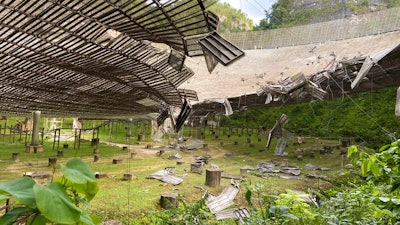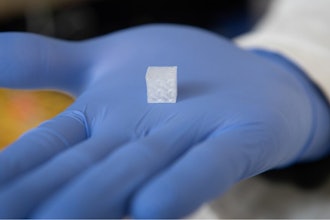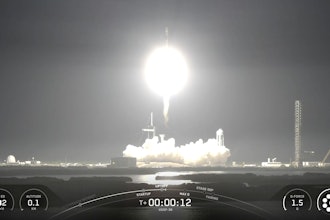
SAN JUAN, Puerto Rico (AP) — The National Science Foundation announced Thursday that it will close the huge telescope at the renowned Arecibo Observatory in Puerto Rico in a blow to scientists worldwide who depend on it to search for planets, asteroids and extraterrestrial life.
The independent, federally funded agency said it’s too dangerous to keep operating the single dish radio telescope -- one of the world’s largest -- given the significant damage it recently sustained. An auxiliary cable broke in August and tore a 100-foot hole in the reflector dish and damaged the dome above it. Then on Nov. 6, one of the telescope’s main steel cables snapped, leading officials to warn that the entire structure could collapse.
NSF officials noted that even if crews were to repair all the damage, engineers found that the structure would still be unstable in the long term.
“This decision is not an easy one for NSF to make, but the safety of people is our number one priority,” said Sean Jones, the agency’s assistant director for the Mathematical and Physical Sciences Directorate. “We understand how much Arecibo means to this community and to Puerto Rico.”
He said the goal was to preserve the telescope without placing people at risk, but, “we have found no path forward to allow us to do so safely.”
The telescope was built in the 1960s with money from the Defense Department amid a push to develop anti-ballistic missile defenses. In its 57 years of operation, it endured hurricanes, endless humidity and a recent string of strong earthquakes.
The telescope boasts a 1,000-foot-wide (305-meter-wide) dish featured in the Jodie Foster film “Contact” and the James Bond movie “GoldenEye.” Scientists worldwide have used the dish along with the 900-ton platform hanging 450 feet above it to track asteroids on a path to Earth, conduct research that led to a Nobel Prize and determine if a planet is potentially habitable.
In recent years, the NSF-owned facility has been managed by the University of Central Florida.
Alex Wolszczan, a Polish-born astronomer and professor at Pennsylvania State University who helped discover the first extrasolar and pulsar planets, told The Associated Press that while the news wasn't surprising, it was disappointing. He worked at the telescope in the 1980s and early 1990s.
“I was hoping against hope that they would come up with some kind of solution to keep it open,” he said. “For a person who has had a lot of his scientific life associated with that telescope, this is a rather interesting and sadly emotional moment.”
The announcement saddened many beyond the scientific world as well, with the hashtag #WhatAreciboMeansToMe popping up on Twitter along with pictures of people working, visiting and even getting married or celebrating a birthday at the telescope.
Ralph Gaume, director of NSF’s Division of Astronomical Sciences, stressed that the decision has nothing to do with the observatory’s capabilities, which have allowed scientists to study pulsars to detect gravitational waves as well as search for neutral hydrogen, which can reveal how certain cosmic structures are formed.
“The telescope is currently at serious risk of unexpected, uncontrolled collapse,” he said. “Even attempts at stabilization or testing the cables could result in accelerating the catastrophic failure.”
Officials suspect a potential manufacturing error is to blame for the auxiliary cable that snapped after a socket holding it failed, but say they are surprised that a main cable broke about three months later given that it was supporting only about 60% of its capacity. Engineers had assessed the situation after the first cable broke, noting that about 12 of the roughly 160 wires of the second cable that eventually broke had already snapped, said Ashley Zauderer, program officer for Arecibo Observatory at NSF.
“It was identified as an issue that needed to be addressed, but it wasn’t seen as an immediate threat,” she said.
She and other NSF officials said that all standard maintenance procedures had been followed.
The closure is a blow for many of the more than 250 scientists that have used a telescope that is also considered one of Puerto Rico’s main tourist attractions, drawing some 90,000 visitors a year. It also has long served as a training ground for hundreds of graduate students.
“It was my Disney,” wrote Edgard Rivera-Valentín, a Universities Space Research Association scientist at the Lunar and Planetary Institute in Texas, in a series of tweets. He recalled first visiting when he was 4 or 5.
"Think about what the Golden Gate Bridge means to San Francisco, Statue of Liberty to New Yorkers. Arecibo is this and more to Puerto Rico because it has gone beyond an icon.”
The NSF said it intends to restore operations at the observatory’s remaining assets including its two LIDAR facilities, one of which is located in the nearby island of Culebra. Those are used for upper atmospheric and ionospheric research, including analyzing cloud cover and precipitation data. Officials also aim to resume operations at the visitor center.
Wolszczan, the astronomer, said the value of the telescope won't instantly disappear because he and many other scientists are still working on projects based on observations and data taken from the observatory.
“The process of saying goodbye to Arecibo will certainly take some years,” he said. “It won't be instantaneous.”






















